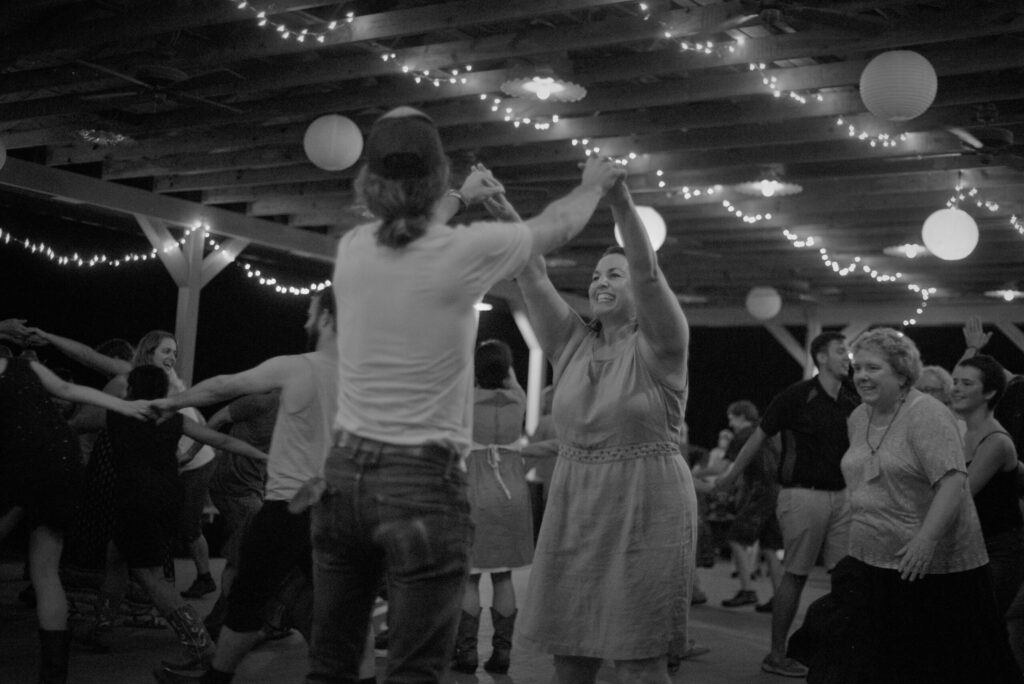Growing up in West Virginia, I was first exposed to Appalachian culture when I was about thirteen years old. Some of my fondest memories involve attending the monthly square dances. Waiting for the start of a square dance, my closest childhood friends and I would sit on one of the coarse benches deeply conversing, our dangling legs swinging back and forth in anticipation for the call that would soon come. Now, when I revisit the open and spacious pavilion, I examine the small details that I somehow missed until now. I see every nick and scuff on the worn, wooden floors, which serves as a memory holder. They symbolize the energy that was once created by those from both the past and present, each leaving their own little mark for those of the future to feel. Being surrounded by such symbolism demands that one take a minute to be present and live in the moment.
Square dances were originally used to allow interaction within and between the communities. In earlier times, it was not acceptable for there to be touching in public, so as an excuse to have that desired physical connection with people, square dances were created (Square Dancing 1). The interesting and unique part about square dances is that one is constantly changing partners, unlike other forms of social dancing where there is one set partner for each dance. During these dances the caller, the person who instructs the dance as the band is playing, will use words that go along with the Appalachian dialect. The narration of the dances was passed down through generations to keep this special tradition alive. The entire purpose of square dancing is centered around providing an environment for generations to come together to preserve West Virginia’s heritage and establish a strong sense of community.

Square dancing started in the 1600s when English performers choreographed combinations, also known as the Morris dance. This act inspired the movements and growth of English country dance. Surrounding countries also hinted at inspiring and influencing the evolution of square dancing as the popularity of folk dancing took off in Scotland, Scandinavia, Spain, and France. As this form of dance made its way to Appalachia, participants turned away from memorizing the steps of the dances and instead, listened for instructions from the caller (Square Dancing 2).
The Appalachian square-dancing community carries memories from lives before and intermingles them together with the lives of current dancers. The history of square dancing informs fellow participants of this special tradition so that they might forever keep it in their hearts and continue the tradition of passing down the history to their family and friends. As time moves on, people continuously pass through. This dancing community will continue to fill with more meaning to everyone that enters. For me, a piece of my life will forever be embedded with the rich history of the social act of interaction with my own community.
Written by: Eliana McCutcheon
Bio: My name is Eliana McCutcheon, and I am from Elkins, West Virginia. I am a currently enrolled full-time student at Davis & Elkins College, where I am majoring in English and minoring in Communications.
“Square Dancing: A Swinging History.” History.com, A&E Television Networks, 29 Nov. 2011, www.history.com/news/square-dancing-a-swinging-history.


Hi Ellie! Growing up in Elkins, I, too, have early memories of square dancing. My first memory of square dancing was at the Elkins City Park with my grandfather as musicians played a variety of music—I remember blue grass specifically—and watching the couples locked arm-in-arm as we sat under the pavilion together. At least once a month we spent under those pavilions, watching musicians stringing their instruments and dancers swinging their partners around. Unfortunately I have two left feet, so I’ll continue observing and leave the dancing to the professionals!
Interesting information! From someone who does not know much about a tradition like square dancing, you painted a clear picture! I enjoyed learning the history and way of square dancing through your words. Understanding how the Appalachian culture is expressed through the way of dance is something that I feel is taken for granted in today’s time. With your usage and connection through older times of dance and today’s world of dance, it is easy to understand and to express the history and culture within the community of Appalachian culture.